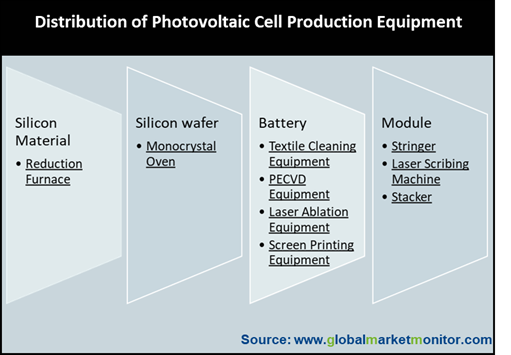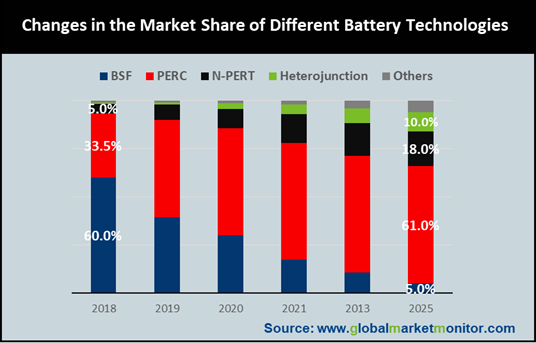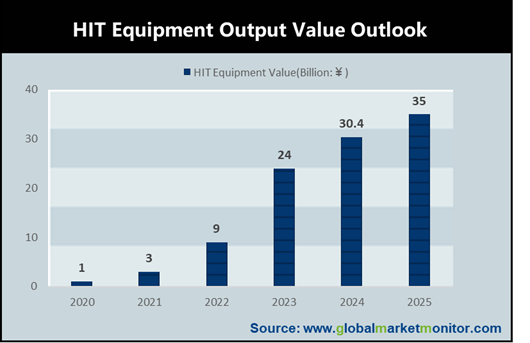Photovoltaic equipment is the core link in the efficiency improvement of the photovoltaic industry: the photovoltaic industry chain can be divided into the preparation of upstream crystalline silicon raw materials, the manufacture of silicon rods/wafers; the manufacturing of cells and modules in the middle reaches, and the application of downstream photovoltaic systems.
In the past few years, through the localization of imported equipment in the industrial chain, the expansion of production capacity to form economies of scale, and the transfer of production capacity to low-cost areas, the cost of photovoltaic installations has dropped significantly. So far, the photovoltaic industry has approached the limit on the route of reducing costs, and the future development direction is to increase efficiency. The essence of the photovoltaic industry is one generation of technology, one generation of technology, one generation of equipment, among which equipment is the core bottleneck.
Photovoltaic equipmentstarts from upstream polysilicon materials to photovoltaic modules including polysilicon reduction furnace, slicer machine, cell equipment, and module automation equipment.
Enquire before purchasing this report-
https://globalmarketmonitor.com.cn/request.php?type=3&rid=202672

Polysilicon Reduction Furnace: Benefiting from the Expansion of Domestic Silicon Material Production
Silicon production capacity and output in China have continued to increase, reaching 452,000 tons and 34.4 tons respectively in 2019, in which the silicon production as a proportion of the world's total output continues to increase, reaching 66.28% in 2019.
Before 2010, polysilicon maintained a profitable state for a long time, which drove the disorderly expansion of domestic and international polysilicon production capacity. In 2012, the global polysilicon production capacity exceeded 400,000 tons, which was basically close to the current demand for polysilicon. At the same time, compared with other links, it was not until 2018 that global polysilicon production capacity exceeded the peak of 2012, while the production volume of other links reached a new high in 2015.
If you consider the new expansion of the industry in 2019 to be about 200,000 tons, the market space for equipment brought about by this expansion is about 20 billion yuan. Calculating with 3000 tons of polysilicon corresponding to 1GW production capacity, if the downstream demand scale increases by 20GW annually in the next 5 years, the corresponding equipment demand will be 6 billion yuan per year.
In the polysilicon preparation link, the core equipment is a polysilicon reduction furnace, which is worth about 50-60 million yuan per 10,000 tons. Foreign suppliers of polysilicon reduction furnace equipment mainly include German GEC and American GT. The domestic suppliers mainly include Shuangliang Eco-energy Systems, Shanghai Morimatsu, and Kaiyuan Chemical.
Wafer Equipment Link: Monocrystal Oven Has Large Value
As the route for monocrystalline to replace polycrystalline is determined, the market share of high-efficiency monocrystalline is gradually expanding. Compared with polycrystalline cells, monocrystalline cells have natural advantages in terms of product efficiency. polycrystalline cells are fully used in black silicon technology, and the monocrystalline cells are widely popularized in PERC technology. It is expected that all polycrystalline fields will be replaced by PERC technology within 2-3 years. Due to the different crystal growth processes, monocrystalline silicon wafers and polycrystalline silicon wafers are significantly different from single crystals in terms of crystal quality, electrical properties, and mechanical properties, where monocrystalline silicon has fewer defects, higher mechanical strength, lower fragmentation rate, and greater room for efficiency improvement, and higher intensiveness, and longer decay period.
With the continuous development of the photovoltaic market, high-efficiency cells will become the market leader. In 2019, the market share of monocrystalline silicon wafers exceeded 50%. The application and promotion of batteries and N-type PERT batteries, the market share of N-type monocrystalline silicon wafers will also increase year by year, and the market share of monocrystalline silicon wafers will gradually increase in the future.
Zhejiang Jingsheng and Dalian Linton NC are the leader in the monocrystal oven field. According to the downstream manufacturers' planning, the new capacity of 19GW, 26GW, and 47GW designed for 2019-2021 have the demand for a monocrystal oven of 1,900, 2,600, and 4700, respectively. The main manufacturers of monocrystalline furnaces in the Chinese market are Jingsheng Electromechanical, Dalian Liancheng, and Beijing Express. Foreign Monocrystal Oven manufacturers have basically withdrawn from the domestic market.
Photovoltaic Slice: Diamond Wire Slice Is Better Than Mortar Slice
Slicing is an important part of the entire silicon wafer processing process. Compared with traditional mortar slice, diamond wire slicing, as a new cutting technology, has the advantages of thin slice cutting, reducing cut loss, and improving processing efficiency, and increasing film yield, and reducing sewage, and COD emissions. It can greatly reduce the production cost of silicon wafers and improve the quality of silicon wafers.
The future market space of the diamond wire slicer depends on the expansion of monocrystalline and polysilicon wafers, the transformation of a small number of polysilicon wafer production lines, and the launch of efficient new products to iterate backward production capacity.
In 2019, the output of silicon wafers reached 135GW, with a new output of about 20GW. Based on the current main slicing machine model of Wuxi Shangji Automation, the annual production capacity of each slicing machine is 43MW, and the average price is between 1.8 and 2 million yuan. We conservatively estimate the market space of the photovoltaic slicer corresponding to 900 million yuan. The annual output of new silicon wafers in the next few years is expected to exceed 20GW with the approach of the parity photovoltaic, and the annual new demand for photovoltaic slicing machines in the market is expected to exceed 1 billion yuan in the next 2-3 years.
It is estimated that in the next two years, the demand for renewal of the backward production capacity will be about 1 billion yuan. In 2018, the production of silicon wafers was 135GW, accounting for about 98% of the global production of silicon wafers. According to ideal conditions, the global stock slicer is about 2,800~3,000, and the market space of stock slicer is about 5-6 billion yuan.
At present, the photovoltaic diamond wire slicing machine in China is mainly competed with Wuxi Shangji Automation and Dalian Linton NC. From 2015 to 2018, the cumulative sales of the machine slicer of Wuxi Shangji Automation were nearly 1.5billion yuan, accounting for about 45% of the domestic slicing equipment market. Also, foreign slicing equipment manufacturers have basically withdrawn from the domestic market of slicing machines.

Cell Equipment: Look at PERC in the Short Term and HIT in the Medium and Long Term
Improving the conversion efficiency of photovoltaic cells has always been the goal pursued by the photovoltaic industry. A variety of high-efficiency battery technology routes mainly selected by the photovoltaic industry. In 2018, the average conversion efficiency of mass-produced polycrystalline black silicon cells reached 19.2%, and the efficiency of monocrystalline and polycrystalline silicon cells using PERC cell technology increased to 21.8% and 20.3%, an increase of 0.5% and 0.3% respectively from 2017 percentage point.
In the field of PERC equipment, Shenzhen S.C and Suzhou Maxwell has occupied the dominant position. Among them, the front-end equipment of the PERC production line takes Shenzhen S.C as the industry leader; the back-end equipment takes Suzhou Maxwell as the market leader; the laser SE and laser slotting equipment take Wuhan Dr Laser as the industry leader.
HIT battery has become the industry-recognized ultimate solution for future battery technology due to its high photoelectric conversion efficiency, excellent performance, which offers good prospects for low-cost Internet access. It was once called the candidate technology for the next generation of commercial photovoltaic production in the industry.
Since PERC cannot be upgraded to HIT, battery factories will start a new round of capital expenditure cycle. The equipment price is expected to drop from 500 million to 400 million, with the potential to drop to 350 million in the future, which is excepted that the equipment output value in 2025 will be 35 billion yuan.

HIT batteries are already in the preliminary stage of industrialization. New and old players in the industry have accelerated the production of HIT battery production lines. It is estimated that about 4-7GW of HIT will be put into operation in China in 2020.
The four major process steps of HIT are "texturing cleaning, amorphous silicon film deposition, TCO preparation, electrode preparation", and the corresponding equipment is cleaning texturing equipment and CVD equipment, mainly PECVD, HWCVD less, PVD/RPD equipment, screen printing equipment.
Shenzhen S.C and Suzhou Maxwell have the strongest comprehensive strength, which is expected to become equipment enterprises top 2.
In 2018, the global photovoltaic penetration rate was only 2.2%. If all photovoltaic power generation is used, 2,2216GW of photovoltaic installed capacity will be required, which is 45 times that of photovoltaic installed capacity at the end of 2018. In the past 10 years, the average global power growth rate was 3%. If the incremental market is totally given to photovoltaics, the annual new market for photovoltaics will be more than 600GW. Photovoltaic has become the most competitive power generation method in most regions of the world, and the current annual new installed capacity is only 100-120GW expected to grow to 200-300GW in the future. The corresponding battery production capacity will continue to expand, so photovoltaic equipment is a high-quality track with long-term growth.
LEARN MORE:
Solar Cell (Photovoltaic) Equipment
Solar Battery System
https://www.globalmarketmonitor.com/reports/589916-solar-battery-system-market-report.html
Solar Photovoltaic
https://www.globalmarketmonitor.com/reports/406047-solar-photovoltaic-market-report.html
We provide more professional and intelligent market reports to complement your business decisions.